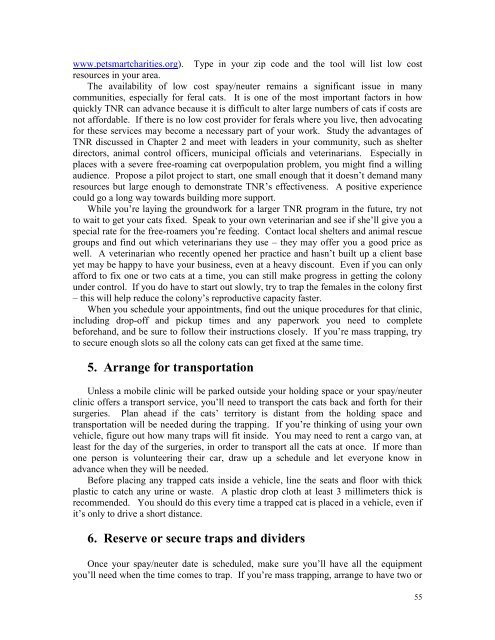download/print - Neighborhood Cats
download/print - Neighborhood Cats
download/print - Neighborhood Cats
- No tags were found...
Create successful ePaper yourself
Turn your PDF publications into a flip-book with our unique Google optimized e-Paper software.
www.petsmartcharities.org). Type in your zip code and the tool will list low costresources in your area.The availability of low cost spay/neuter remains a significant issue in manycommunities, especially for feral cats. It is one of the most important factors in howquickly TNR can advance because it is difficult to alter large numbers of cats if costs arenot affordable. If there is no low cost provider for ferals where you live, then advocatingfor these services may become a necessary part of your work. Study the advantages ofTNR discussed in Chapter 2 and meet with leaders in your community, such as shelterdirectors, animal control officers, municipal officials and veterinarians. Especially inplaces with a severe free-roaming cat overpopulation problem, you might find a willingaudience. Propose a pilot project to start, one small enough that it doesn’t demand manyresources but large enough to demonstrate TNR’s effectiveness. A positive experiencecould go a long way towards building more support.While you’re laying the groundwork for a larger TNR program in the future, try notto wait to get your cats fixed. Speak to your own veterinarian and see if she’ll give you aspecial rate for the free-roamers you’re feeding. Contact local shelters and animal rescuegroups and find out which veterinarians they use – they may offer you a good price aswell. A veterinarian who recently opened her practice and hasn’t built up a client baseyet may be happy to have your business, even at a heavy discount. Even if you can onlyafford to fix one or two cats at a time, you can still make progress in getting the colonyunder control. If you do have to start out slowly, try to trap the females in the colony first– this will help reduce the colony’s reproductive capacity faster.When you schedule your appointments, find out the unique procedures for that clinic,including drop-off and pickup times and any paperwork you need to completebeforehand, and be sure to follow their instructions closely. If you’re mass trapping, tryto secure enough slots so all the colony cats can get fixed at the same time.5. Arrange for transportationUnless a mobile clinic will be parked outside your holding space or your spay/neuterclinic offers a transport service, you’ll need to transport the cats back and forth for theirsurgeries. Plan ahead if the cats’ territory is distant from the holding space andtransportation will be needed during the trapping. If you’re thinking of using your ownvehicle, figure out how many traps will fit inside. You may need to rent a cargo van, atleast for the day of the surgeries, in order to transport all the cats at once. If more thanone person is volunteering their car, draw up a schedule and let everyone know inadvance when they will be needed.Before placing any trapped cats inside a vehicle, line the seats and floor with thickplastic to catch any urine or waste. A plastic drop cloth at least 3 millimeters thick isrecommended. You should do this every time a trapped cat is placed in a vehicle, even ifit’s only to drive a short distance.6. Reserve or secure traps and dividersOnce your spay/neuter date is scheduled, make sure you’ll have all the equipmentyou’ll need when the time comes to trap. If you’re mass trapping, arrange to have two or55








